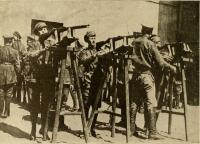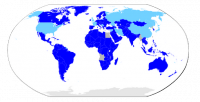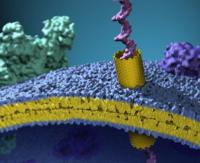-
Massive 2014 West Virginia chemical spill was preventable: CSB
The Chemical Safety Board’s (CSB) final report into the massive 2014 release by Freedom Industries of chemicals into the primary source of drinking water of Charleston, West Virginia, concludes that Freedom Industries failed to inspect or repair corroding tanks, and that as hazardous chemicals flowed into the Elk River, the water company and local authorities were unable effectively to communicate the looming risks to hundreds of thousands of affected residents, who were left without clean water for drinking, cooking, and bathing.
-
-
HHS sponsors inhaled chlorine antidote for chemical terrorism preparedness

Chlorine gas is a widely available industrial chemical with catastrophic consequences in industrial accidents. chlorine gas has been used as a weapon, for the first time in the First World War and repeatedly in the recent Syrian civil war. Currently, there is no specific antidote for lung injuries caused by chlorine exposure, and treatment has been limited supportive care. The first potential antidote to treat the life-threatening effects of chlorine inhalation, a potential terrorism threat, will advance in development under a contract between the U.S. Department of Health and Human Services’ (HHS) Office of the Assistant Secretary for Preparedness and Response (ASPR) and Radikal Therapeutics, Inc. of Beverly, Massachusetts.
-
-
Sudan used chemical weapons against civilians in Darfur
An Amnesty International investigation has gathered evidence of the repeated use of what are believed to be chemical weapons against civilians, including very young children, by Sudanese government forces in one of the most remote regions of Darfur over the past eight months. The investigators, using satellite imagery, more than 200 in-depth interviews with survivors, and expert analysis of dozens of images showing babies and young children with chemical weapons-related injuries, the investigation indicates that at least thirty likely chemical attacks have taken place in the Jebel Marra area of Darfur since January 2016. The most recent was on 9 September 2016.
-
-
Radioactive wastewater enters Florida major aquifer after huge sinkhole opens up below fertilizer plant
At least 980 million liters of highly contaminated water — including radioactive substances – has leaked into one of Florida’s largest sources of drinking water. The leak was caused by a huge sinkhole which opened up beneath a fertilizer plant near Tampa. The sinkhole caused highly contaminated waste water to pass into an aquifer which supplies much of the state. The waste water contained phosphogypsum, a by-product of fertilizer production, which contains naturally occurring uranium and radium. the Floridan aquifer aquifer underlies all of Florida and extends into southern Alabama, Georgia, and South Carolina, supplying groundwater to the cities of Tallahassee, Jacksonville, Gainesville, Orlando, Daytona Beach, Tampa, and St Petersburg.
-
-
Assessing the risk from Africa as Libya loses its chemical weapons
Libya’s remaining chemical weapons left over from the Gaddafi regime are now being safely disposed of in a German facility. This eliminates the risk of them falling into the wrong hands. But can these same hands acquire weapons of mass destruction from the rest of Africa? The disposal of Libya’s chemical weapons has lowered the risk of weapons of mass destruction in Africa. But we have seen how far non-state actors are willing to go to either produce or steal such weapons. For example, analysts envision militants known as “suicide infectors” visiting an area with an infectious disease outbreak like Ebola purposely to infect themselves and then using air travel to carry out the attack. Reports from 2009 show forty al-Qaeda linked militants being killed by the plague at a training camp in Algeria. There were claims that they were developing the disease as a weapon. The threat WMD pose cannot be ignored. African countries, with help from bilateral partners and the international community, have broadened their nonproliferation focus. They will need to keep doing so if the goal is effectively to counter this threat.
-
-
Cleaning concrete contaminated with chemicals
In March 1995, members of a Japanese cult released the deadly nerve agent sarin into the Tokyo subway system, killing a dozen people and injuring a thousand more. This leads to the question: What if a U.S. transportation hub was contaminated with a chemical agent? The hub might be shut down for weeks, which could have a substantial economic impact. Craig Tenney, a chemical engineer at Sandia National Laboratories, is looking for better ways to clean contaminated concrete to reduce that impact.
-
-
ISIS fired chemical shells at U.S., Iraqi troops near Mosul
U.S. defense officials say that on Tuesday ISIS has fired a shell containing mustard agent at the Qayarrah air base south of Msoul. U.S. and Iraqi troops use the base for operations against the Islamist group. No U.S. or Iraqi troops were hurt, and none has shown symptoms of exposure. One official told CNN that the agent had “low purity” and was “poorly weaponized.” A second official described it as “ineffective.”
-
-
Why ratifying the Chemical Weapons Convention is in Israel’s best interest
When the time came to commemorate the 100th anniversary of the first major use of chemical weapons, it seemed there was at last a real chance of ridding the world of all chemical weapons in the very near future. Almost all countries had already joined the Chemical Weapons Convention (CWC), which commits countries to the supervised destruction of all stockpiles of chemical weapons – with only two states as yet unwilling to sign: North Korea and Egypt. But there’s another exception: Israel, which has signed the convention but is refusing to ratify it. Chemical weapons have no place in a civilized society. They have little to no use as a tactical deterrent, and their effects are indiscriminate and appalling. We have a unique opportunity to rid the world of this scourge, and we’re so close to doing so. It’s high time Israel joined the rest of the world.
-
-
FBI’s WMD Directorate marks its first decade
If you can imagine a disaster involving explosives or the release of nuclear, biological, chemical, or radioactive material, there is a pretty good chance a group of subject-matter experts within the FBI has built an elaborate scenario around it and tested how well emergency responders face up to it. It is the main jobs of the Weapons of Mass Destruction (WMD) Directorate — to imagine worst-case scenarios and then devise ways to prevent and prepare for them. The Directorate was created ten years ago, on 26 July 2006.
-
-
Syria chlorine attack claims: what this chemical is and how it became a weapon
New claims that the Syrian government has dropped barrel bombs full of chlorine on a suburb of Aleppo are the latest in a series of allegations of chemical weapon use. Although the Syrian government denies using chemical weapons, a recent UN-led enquiry found it had used chlorine on at least two occasions. The first gas attack using chlorine was launched on 22 April 1915 in the trenches on the Western front, near Ypres. Gas masks were developed to protect against chlorine attacks and other chemical warfare agents were developed. But chlorine remains the simplest chemical weapon and reappeared on the battlefield during the Iraq War and allegedly now in Syria. In the Second World War, both sides of the conflict knew that the other side had weaponized chlorine and refrained from using it. Today in Syria, it sadly appears this may not have been the case.
-
-
Libya’s remaining chemical weapons materials removed

The director-general of the Organization for the Prohibition of Chemical Weapons (OPCW), ambassador Ahmet Üzümcü, announced a milestone in the operation to verifiably eliminate Libya’s remaining chemical weapons stocks by confirming that the chemicals have been successfully removed from Libya on 27 August 2016.
-
-
Watchdog: Evidence suggests Assad kept chemical weapons program in violation of 2013 deal
After launching a lethal sarin gas attack in August 20013 — which killed 1,400 Sunni civilians in a Damascus suburb — the Assad regime agreed to get rid of its nerve agents under the supervision of OPWC, the UN chemical weapons watchdog. In summer 2014 OPCW announced that Syria’s declared chemical weapons stockpile had been removed – but in a classified report submitted Wednesday to the Security Council, OPWC says that Syria has violated the 2013w agreement by keeping some of its chemical weapons program, and by continuing to use chemical weapons in attacks against civilians.
-
-
“Liquid fingerprinting” technique identifies unknown liquids instantly
A new company — Validere — will commercialize sensing technology invented at Harvard University that can perform instant, in-field characterization of the chemical make-up and material properties of unknown liquids. Validere aims to develop the licensed technology, called Watermark Ink (W-INK), into a pocket-sized device that could be used by first responders to quickly identify chemical spills, or by officials to verify the fuel grade of gasoline right at the pump.
-
-
“Second skin” uniform protects soldiers from biological, chemical agents in the field

In work that aims to protect soldiers from biological and chemical threats, scientists have created a material that is highly breathable yet protective from biological agents. This material is the first key component of futuristic smart uniforms that also will respond to and protect from environmental chemical hazards.
-
-
Block MEMS awarded $9.8M contract for standoff detection of chemical threats
Block MEMS, a developer of Quantum Cascade Laser (QCL)-based infrared detection systems, has been awarded a $9.8 million contract from the Intelligence Advanced Research Projects Activity (IARPA) to develop a system that can detect trace quantities of chemicals at standoff distances of at least 100 ft.
-
- All
- Regional
- Water
- Biometrics
- Borders/Immig
- Business
- Cybersecurity
- Detection
- Disasters
- Government
- Infrastructure
- International
- Public health
- Public Safety
- Communication interoperabillity
- Emergency services
- Emergency medical services
- Fire
- First response
- IEDs
- Law Enforcement
- Law Enforcement Technology
- Military technology
- Nonlethal weapons
- Nuclear weapons
- Personal protection equipment
- Police
- Notification /alert systems
- Situational awareness
- Weapons systems
- Sci-Tech
- Sector Reports
- Surveillance
- Transportation
Advertising & Marketing: advertise@newswirepubs.com
Editorial: editor@newswirepubs.com
General: info@newswirepubs.com
2010-2011 © News Wire Publications, LLC News Wire Publications, LLC
220 Old Country Road | Suite 200 | Mineola | New York | 11501
Permissions and Policies
Editorial: editor@newswirepubs.com
General: info@newswirepubs.com
2010-2011 © News Wire Publications, LLC News Wire Publications, LLC
220 Old Country Road | Suite 200 | Mineola | New York | 11501
Permissions and Policies
